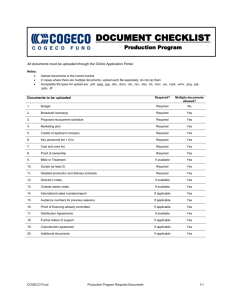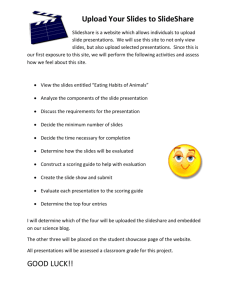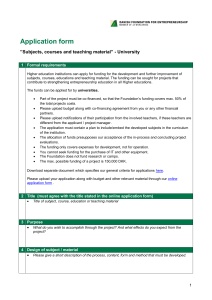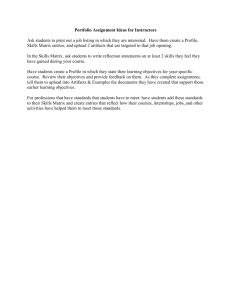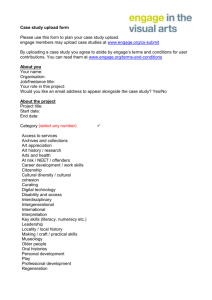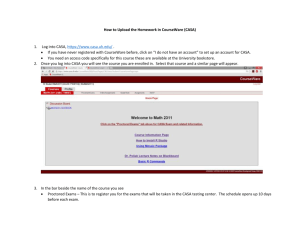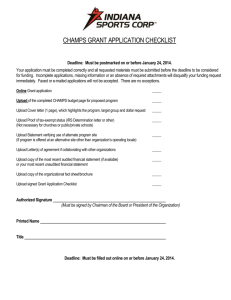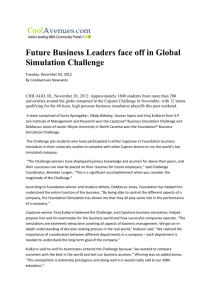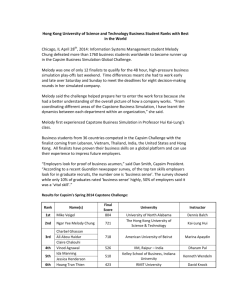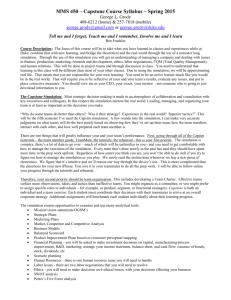Syllabus - Mahidol University International College
advertisement
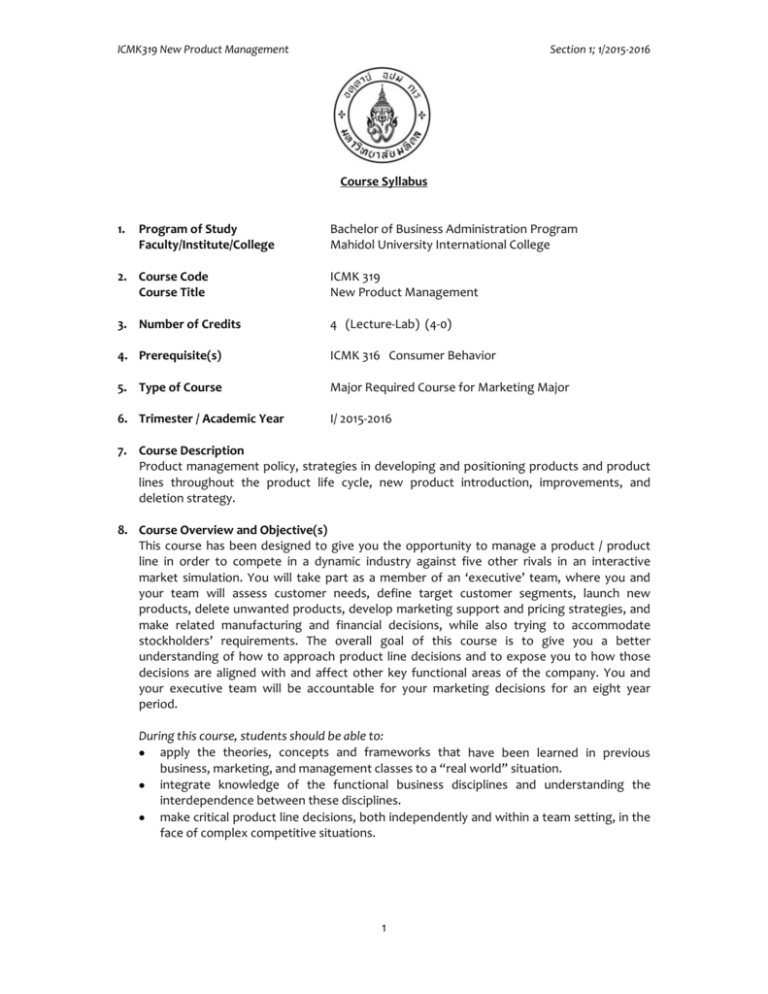
ICMK319 New Product Management Section 1; 1/2015‐2016 Course Syllabus 1. 2. 3. 4. 5. 6. 7. Program of Study Faculty/Institute/College Bachelor of Business Administration Program Mahidol University International College Course Code Course Title ICMK 319 New Product Management Number of Credits 4 (Lecture‐Lab) (4‐0) Prerequisite(s) ICMK 316 Consumer Behavior Type of Course Major Required Course for Marketing Major Trimester / Academic Year I/ 2015‐2016 Course Description Product management policy, strategies in developing and positioning products and product lines throughout the product life cycle, new product introduction, improvements, and deletion strategy. 8. Course Overview and Objective(s) This course has been designed to give you the opportunity to manage a product / product line in order to compete in a dynamic industry against five other rivals in an interactive market simulation. You will take part as a member of an ‘executive’ team, where you and your team will assess customer needs, define target customer segments, launch new products, delete unwanted products, develop marketing support and pricing strategies, and make related manufacturing and financial decisions, while also trying to accommodate stockholders’ requirements. The overall goal of this course is to give you a better understanding of how to approach product line decisions and to expose you to how those decisions are aligned with and affect other key functional areas of the company. You and your executive team will be accountable for your marketing decisions for an eight year period. During this course, students should be able to: apply the theories, concepts and frameworks that have been learned in previous business, marketing, and management classes to a “real world” situation. integrate knowledge of the functional business disciplines and understanding the interdependence between these disciplines. make critical product line decisions, both independently and within a team setting, in the face of complex competitive situations. 1 ICMK319 New Product Management Section 1; 1/2015‐2016 9. Course Outline* Week Topics Remarks Formation of Executive Teams Distribution of Foundation Team Member Guide 1 Introduction to the Course Topic 1: New Product Management 2 Topic 2: Product Development and Strategic Alignment Simulation Mechanics 3 Topic 3: Organizing The Product Management Team Topic 4: Cross‐functional Interfaces Practice Round Debriefing 4 Topic 5: The Situation Analysis Topic 6: Industry Demand and Sales Forecasting 5 Debriefing Topic 7: Perceptual Mapping and Market Segmentation 6 Debriefing Topic 8: Consumer Needs Analysis Upload CR2 decisions by 12:00 noon, Friday 23 October 2015 7 Debriefing Topic 9: Product Line and Margin Analysis Upload CR3 decisions by 12:00 noon, Friday 30 October 2015 8 Debriefing Topic 10: Portfolio Analysis Upload CR4 decisions by 12:00 noon, Friday 6 November 2015 9 Debriefing Topic 11: Competitor Analysis Upload CR5 decisions by 12:00 noon, Friday 13 November 2015 10 Competitor Analysis Presentations Topic 12: Financial Analysis and Shareholder Value Upload CR6 decisions by 12:00 noon, Friday 20 November 2015 11 Marketing/Financial Analysis Presentations Debriefing Upload CR7 decisions by 12:00 noon, Friday 27 November 2015 12 Marketing Team Pitch and Presentations 13 FINAL EXAMINATION Complete the CAPSIM Registration and Tutorial via www.capsim.com by 20 September 2015* Team assignment and workshop Run Practice Round (PR) 1 decisions in class. Be ready to input your PR1 decisions. Upload PR 2 decisions in class Upload PR3 decisions by 12 noon, Friday 9 October 2015 Upload PR 4 decisions in class Read Industry Conditions Report and R0 FastTrack Upload Competition Round (CR) 1 decisions by 12:00 noon, Friday 9 October 2015 Team introductions Upload Decision 8 by 12:00 noon, Wednesday 2 December 2015 Submission of Marketing Plan and corresponding PowerPoint presentation Upload Decision 8 by 12:00 noon, Wednesday 2 December 2015 Tuesday 8 December 2015; 1000 – 1150 * As of 12 September 2015. This is a tentative schedule subject to change with advanced notice. 10. Teaching Method(s) 1. Interactive lectures and debriefings 2. Interactive business simulation models 3. In‐class participative discussion 4. Team‐based presentations 11. Teaching Media 1. Power‐point presentations 2. FastTrack reports, Simulation spreadsheets 3. Webinars, Community VDOs 4. Handouts (e.g. assignments) 2 ICMK319 New Product Management Section 1; 1/2015‐2016 12. Student Performance Assessment Composition Individual Performance Participation/Attendance (10%) Quizzes/Assignments (10%) Marketing Plan Presentation (5%) Final Examination Team Simulation Performance Achievement of Marketing Goals/Objectives Sales forecast accuracy Management of Contribution Margin Financial performance ‐ (i.e. ROS, stock price, emergency loans) Debriefings Peer evaluations Marketing Plan Total % 25 25 30 20 100% 13. Course Evaluation Scale Grade earned A B+ B C+ C D+ D F Score 90 – 100 85 ‐ 89.99 80 ‐ 84.99 75 ‐ 79.99 70 ‐ 74.99 65 ‐ 69.99 60 ‐ 64.99 0 ‐ 59.99 14. Required Materials Capsim Management Simulations (Student registration) Foundation: A Hands‐on Introduction to Business Fundamentals, Edition 1, Capsim Management Simulations, Inc. Foundation FastTracks and other reports 15. Additional Resources www.capsim.com www.artvscience.com 16. Instructor Assistant Professor Olimpia C. Racela, (D.B.A. Marketing) dr.ocr_MUIC@yahoo.com 17. Course Coordinator Program Director of Marketing Major 3 ICMK319 New Product Management Section 1; 1/2015‐2016 APPENDIX 1: Assessment of Student Performance Participation/Attendance (10%) Participation is demonstrated by active involvement and engagement in class discussion and activities, e.g. sharing ideas, asking insightful questions, answering questions, etc. Attendance alone does not constitute participation. Participation grades will be comprised mainly of the quality and regularity of the comments a student shares, in addition to attendance, punctuality, and preparation. Each student should plan to arrive promptly to class. Late arrivals unfairly disrupt class discussion. If a student is unable to attend a class, he/she should let the instructor know in advance via email. Quizzes/Assignments (10%) To assess each student’s understanding of marketing, product development, and general business terminology, unannounced quizzes and individual assignments will be implemented throughout the semester. The format of quizzes may vary and the marks allocated to each quiz and assignment will depend on the total number implemented during the semester. There are no ‘make‐ups’ for quizzes nor for assignments missed. Capsim Foundation Simulation Performance (30%) The Capsim Foundation* simulation is the highlight of this new product management course. You will run a product line for a company that is competing in a dynamic oligopolistic industry, in which the needs of the customer segments evolve. Your company operations and performance will be influenced not only by the marketing decisions made by you and your executive team, but also by the decisions made by your competitors. Our focus will be on the product line decisions that you make over an eight‐year period. Thus, your scores/grades for the Foundation* simulation primarily will be based on your company’s 8‐ year marketing results, per the product/marketing strategies and metrics that your team selects. Capsim Foundation* is designed to keep track of each team member’s and each company’s performance. There will be adjustments to student and team grades based on the learning experiences that your team shares with the class and based on the peer evaluations. Teams will be rewarded with bonus ‘investments’ into their company via the leadership, entrepreneurship and/or practical creativity demonstrated by an individual team member. Team overall performance will be comprised of: Marketing Goals Sales Forecast Accuracy Contribution Margin Financial performance Team‐led Debriefings Peer Evaluations Team Foundation Company Summary and Individual Presentation (25%) Toward the end of the semester, each team is to prepare a Summary Write‐up and a corresponding PowerPoint presentation of approximately 15 minutes. The Summary Write‐up will comply with the following content: Page 1. Company Mission Statement Page 2. Company Business Strategy Pages 3‐ 7. Individual product strategy, decision results, analyses, and results for the company’s specific products Page 8. Company Summary Review (achievements and failures) Page 9. Outlook ‐ What would you, or the team, had done differently? Page 10. Conclusion ‐ What did you learn from the simulation experience? 4 ICMK319 New Product Management Section 1; 1/2015‐2016 Tips on Effective Writing Be organized, clear, and succinct. Keep the writing short and simple. Write in an articulate manner using English that is appropriate and professional. o Do not write in first person (i.e. do not use ‘I’, ‘we’, ‘you’, etc.). o Do not use contractions (i.e. use does not rather than doesn’t, use would not rather than wouldn’t). Assignments and reports will be graded on the following criteria: 1. Clear and thorough application of material covered in the assigned readings, lectures and discussions. 2. Demonstration of original, logical, insightful thinking including a comprehensive analysis of facts, logical synthesis, and persuasive conclusion/recommendation. Specific examples and illustrations should support your analysis. 3. Quality of research (relevance, depth, breadth) and proper acknowledgement, including complete citations and references, when appropriate. 4. Use of appropriate language and tone, accurate spelling, correct grammar, appropriate punctuation, and logical structure. Use spellcheck. The instructor stops reading any work after the third misspelling. 5. Professional formatting and appearance. Presentations will be implemented and evaluated based on the following: 1. Time allotted: 15 minutes for each team; 5‐10 minutes for Q & A. 2. Use PowerPoint and/or other visual aids 3. Each member must take part in the oral presentation and will be evaluated based on the following five criteria a. Content: ideas (novelty, clarity), value of content, logic/reasoning, justification b. Presentation style: personal appearance (attire, posture, expression), speaking (articulation, projection), energy, interest, audience contact c. Organization: opening and concluding remarks, flow of ideas, teamwork d. Mechanics: grammar, gestures, pace of speech e. Use of media: linking media with speaking, linking media with other media (if applicable), knowledgeable handling of media, general appearance of media materials (legibility, layout) 4. Preparedness to handle questions and constructive criticism. APPENDIX 2: Student Conduct Classroom/Professional Courtesy Arrive to class promptly. Late arrivals to the classroom disrupt class discussion. Turn your communication/electronic devices to silent mode. If you must use such devices during class time, do so outside of the classroom by leaving and returning as quietly as possible. Students using their electronic/digital devices may be asked to leave the room. Do not engage in unnecessary or irrelevant talking while there is a lead speaker. The instructor may ask any distracting students to leave the room. No audio taping, videotaping, photographing, or any other method of recording lectures is allowed. The only exception shall be with the prior permission of the instructor. Academic Integrity The academic integrity of the Institution will be strictly upheld. Students must be honest in completing their academic work. Plagiarism and cheating are unacceptable, and if discovered, either will result in the student’s automatic failure. 5
